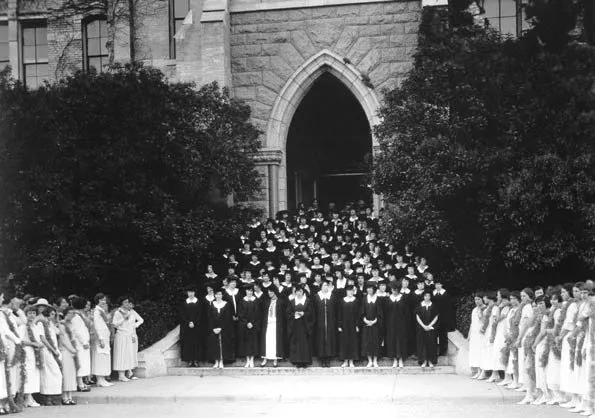Bluebonnet Chain Signified Passing of Leadership On Campus

For almost half a century, springtime on campus was heralded by a sea of bluebonnets and dotted with poppies, yellow daisies, and the bright red blossoms of the prickly pear cactus.
In the 1910s, the wildflowers helped create an annual tradition among University coeds. Inspired by a similar rite at Vassar College, graduating seniors passed an immense, handmade chain of real bluebonnets, representing tradition and responsibility, onto the shoulders of junior girls who were dressed in white.
By 1922, the ceremony became known as “Swing-Out,” and was organized by Cap and Gown, a women’s student organization. The event was intended to recognize women leaders on campus, and to formally transfer the mantle of responsibility to the junior class. It was a prominent part of the annual Senior Week, which featured activities for all graduating seniors, both men and women.
Originally, a chain several hundred feet in length was made from bluebonnets attached to Spanish moss, but the supply of both flowers and moss didn’t last very long. In 1928, a reusable chain of paper bluebonnets was created, and thereafter maintained by the sophomore coeds.
In 1955, Cap and Gown agreed to expand the ceremony to include both women and men, and Swing-Out evolved into an event to honor current student leaders and announce the leaders for the following year, including the new student body president. But the event grew less popular in the 1960s, and the 1964 edition was the last for several decades.
In the 1990s, a new version, called the Swing-Out Awards, was created to honor outstanding accomplishments and contributions by student organizations on campus. They are still presented each April and sponsored by the UT Leadership and Ethics Institute, which is part of the Dean of Students office.

The 1923 Swing-Out ceremony was held in front of the old Main Building.





